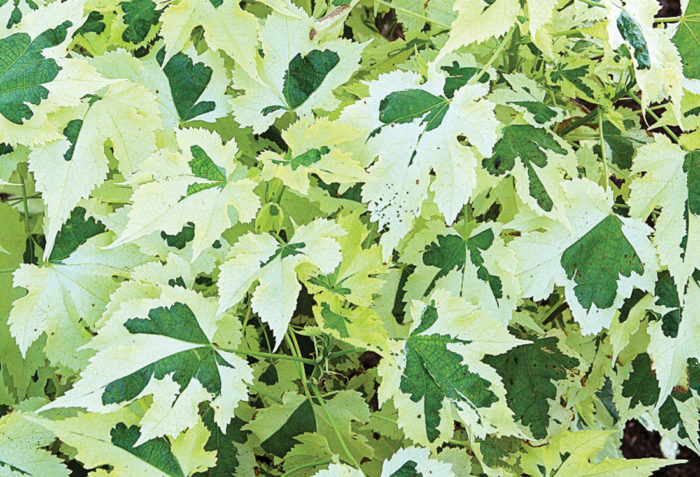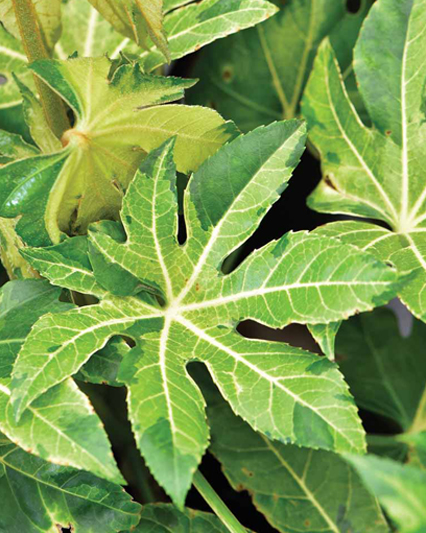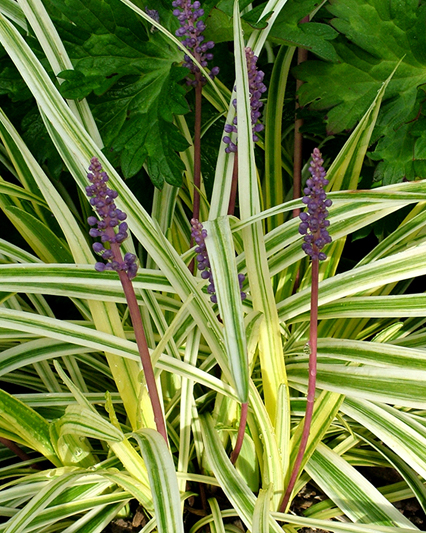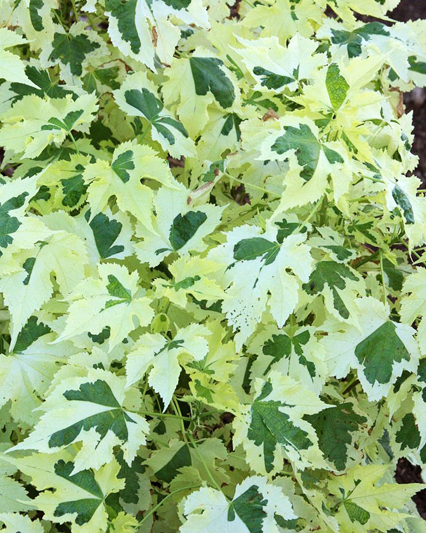
See regional picks for variegated plants for shade, and read the article by Andy Brand for even more ideas.
“While the cool, shady areas have provided me with the opportunity to grow some of my favorite genera, they also have presented me with a fair share of challenges. One of the trickiest issues is figuring out how to brighten the border growing under a dense canopy or in those dark corners. Plants with showy flowers are an obvious solution, but usually their effect is transient, and all too often flowering is diminished with too much shade. An even better option is to incorporate plants with variegated foliage and let their leaves of white, cream, gold, and green bring light to the shade.” Read more in Plants That Shine in the Shade.
1. Camouflage™ Japanese Aralia

Name: Fatsia japonica ‘Variegata’
Zones: 7–10
Size: 5 to 10 feet tall and wide
Conditions: Partial to full shade; moist, well-drained soil
Native range: Japan
Interested in bringing a hint of the tropics into your shade garden? With its graceful shape and dense, colorful foliage, Camouflage™ Japanese aralia is a standout choice. Deeply lobed leaves sport a glossy patchwork of rich green, lime, and yellow, bringing to mind the sun shining through a stained-glass window. Clusters of subtle white flowers attractive to pollinators are followed by small black berries, but the oversize foliage is really the star here. You can plant it in a container, in a shaded entryway, or on a porch for year-round tropical impact too.
2. ‘Silvery Sunproof’ Lily Turf

Name: Liriope muscari ‘Silvery Sunproof’
Zones: 5–11
Size: 15 to 18 inches tall and wide
Conditions: Partial to full shade; well-drained soil
Native Range: China, Taiwan, and Japan
Contrary to its common name, this lily turf is neither silver nor sunproof. Its strappy green leaves are edged with soft gold, making it a striking ground cover or front-of-the-border choice. Pale blue flowers, reminiscent of hyacinths, appear in late summer. This plant is tolerant of full shade but will develop its best color with at least a few hours of sunshine. While it’s technically evergreen, old growth tends to fade and lose its vibrancy. A solid pruning in midwinter before new growth emerges will keep it looking fresh, however. Unlike other lily turf varieties, ‘Silvery Sunproof’ is not invasive and maintains its manicured look.
3. ‘Mr. Goldstrike’ Aucuba

Name: Aucuba japonica ‘Mr. Goldstrike’
Zones: 7–9
Size: 6 to 10 feet tall and wide
Conditions: Partial to full shade; well-drained soil
Native Range: Japan and China
If you crave year-round garden pizzazz but want to keep maintenance to a minimum, you can’t go wrong with ‘Mr. Goldstrike’ aucuba. Medium-size, dark green glossy leaves are liberally speckled with gold, as if Mother Nature happened to shake out her paintbrush nearby. One of the all-time-best tough-as-nails plants, it thrives on benign neglect and is virtually maintenance free. ‘Mr. Goldstrike’ is a male selection that will pollinate female varieties, so if you have room for more than one, plant a companion nearby for a winter show of red berries.
4. ‘Savitzii’ Flowering Maple

Name: Abutilon ‘Savitzii’
Zones: 9–11
Size: 5 feet tall and 3 feet wide
Conditions: Partial shade; moist, well-drained soil
Native Range: Central and Southern Africa
With eye-catching foliage and elegant flowers that are a magnet for hummingbirds, ‘Savitzii’ flowering maple checks all the boxes. Its large, maple-like leaves display an irregular, bold pattern of cream and green. Unlike many variegated plants where the foliage tends to overpower any blossoms, ‘Savitzii’ flowering maple sports cup-shaped orange flowers that bloom nearly year-round and easily stand out, even from a distance. One of this shrub’s most-prized qualities is its ability to form a natural espalier when planted against a wall, making it an ideal choice to soften a shady fence. While evergreen, it has a tendency to get leggy over time and may require an occasional hard pruning to maintain a lush appearance.
—Susan Morrison is a garden designer in Concord, California.
From Fine Gardening #194


















Comments
Log in or create an account to post a comment.
Sign up Log in